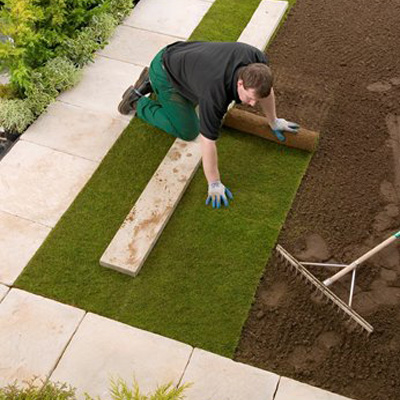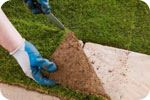How to lay turf
Click on more details to view our ‘How to..’ Video GuidesSoil preparationYour new turf will grow best when your soil is prepared in such a way as to encourage deep, rapid rooting. Turf needs just four things (in the proper proportions) to grow; sunlight, air, water and nutrients. Grass plants obtain three of these essential factors from the soil; air, water and nutrients. You must prepare your soil, the quality of the soil and its preparation will greatly affect the quality of the lawn. The correct depth of soil with the correct structure will ensure that the grass roots penetrate evenly and deeply. This will make the lawn more drought resistant, a more efficient water and nutrient user and will lead to a denser sward of grass plants which helps to crowd out weeds and gives a more visually appealing lawn. Poor soil and poor preparation will cause the turf to deteriorate over time.You need a minimum of 10cm (4″), ideally 15cm (6″) of good soil (The deeper the better). The soil should be loosely turned over and free from surface stone, clods, other debris and perennial weeds. Blended Loam¨ provides an ideal base for laying turf onto. It can also be used to dig into the existing soil to add nutrients and to improve structure which will help with drainage and also water retention.Digging over or rotovating the soil before laying turf is essential. Once the soil has been loosened it should then be lightly compacted. The best way to do this is to walk to and fro over the whole area and then again at right angles to the first direction. After this rake the surface to a fine tilth and make sure that the surface is level. This may take some time but it is worth it as if the surface is uneven it will mean that your lawn is uneven which will cause problems with the appearance of the lawn. The best way to get a level surface is to use Blended Loam¨; it is light, friable and easily worked to give a fine level surface for laying turf onto.It is also a good idea to water the surface a couple of days before the turf arrives. Not only will this provide water for the roots of the turf it can also cause the prepared soil to settle which can then be raked level again just before the turf arrives. Apply a pre turfing fertiliser just ahead of laying the turf.Laying the turfTurf should be laid out immediately. When it is rolled up it is effectively slowly dying as the leaves are not receiving any sunlight.Start laying the turves, preferably along a straight edge, butting closely end to end. On subsequent rows stagger the joints brickwork fashion. Planks should be placed on newly laid turves for walking along and working from. Lightly firm down the turves to ensure good contact between the turves and the soil.The head of a rake held vertically and pressed (tamped) down is ideal. Never use a roller on freshly laid turf. Always push turf into a joint; never stretch the turves by pulling them. Any remaining cracks can be filled with a light soil (Blended Loam¨ is ideal) and tamped down. Turf can be simply cut using a suitable knife or half moon cutting spade around edges and features.WateringYou should always water newly laid turf immediately and for several days after laying until the turf is firmly rooted. The amount of water will depend upon weather conditions at the time but you need to give the turf a really good soaking and ensure that the water has soaked through the turf and into the soil below. First thing in the morning or in the evening are ideal times to water your new turf. Watering is essential however do not over water, this means do not keep watering until large areas are under water, let the water soak in, the water just needs to soak through the turf into the soil below.MowingMowing is the single most important act of maintenance. You can start mowing as soon as five days after the turf has been layed depending upon the time of year if it can be done without disturbing the rooting process. Most people wait too long before mowing. Never take more than one third of the height of the grass off at any one time. It is far better with a new lawn just to ‘top’ it initially and then gradually bring it down to the height required as it sets in to its new environment. Never mow a lawn below 25mm (1″) in height. For the first few cuts of the lawn it is far better to use a light weight mower such as a hand pushed rotary mower or a flymo. Heavy cylinder mowers or ride on mowers can disturb the soil under the turf and cause undulations especially if the soil is wet. If it is not possible to use one of these mowers then make sure that the soil under the turf is firm before mowing.There are three key points about mowing:1)Don’t delay, this can cause disease and cutting too much off the sward at any time will stress the sward. Mow your lawn as soon and often as it needs it. Turf will accept light traffic almost immediately, although it is recommended that you keep off it other than for mowing for the first few weeks.2)Don’t let the grass grow too long, If this does happen reduce the height gradually never cutting more than one third of the height of the grass off at any one time.3)Keep your mower in good condition and ensure that it has sharp blades at all times







